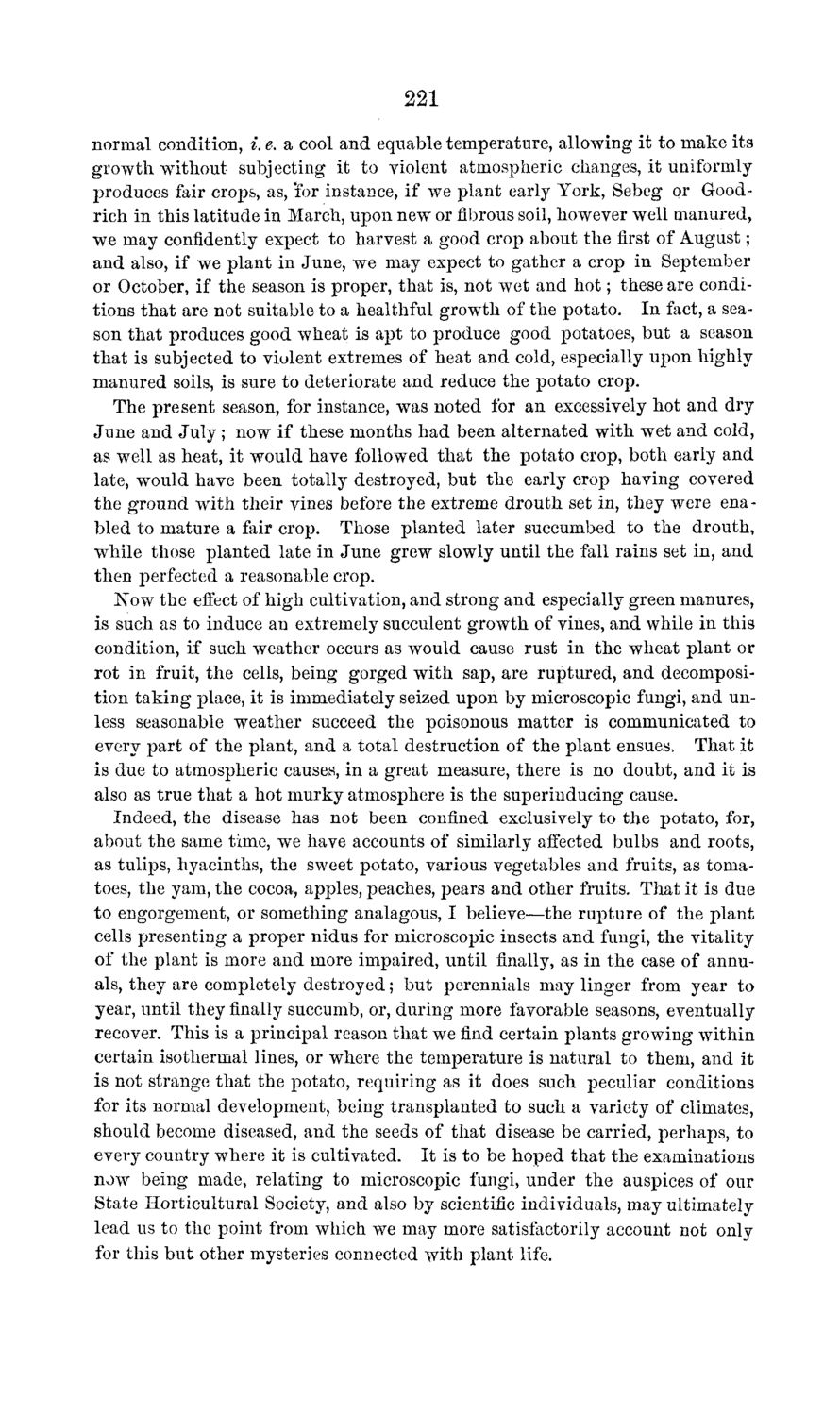| |
| |
Caption: Board of Trustees Minutes - 1869
This is a reduced-resolution page image for fast online browsing.

EXTRACTED TEXT FROM PAGE:
221 normal condition, i. e. a cool and equable temperature, allowing it to make its growth without subjecting it to violent atmospheric changes, it uniformly produces fair crops, as, "for instance, if we plant early York, Sebeg or Goodrich in this latitude in March, upon new or fibrous soil, however well manured, we may confidently expect to harvest a good crop about the first of A u g u s t ; and also, if we plant in June, we may expect to gather a crop in September or October, if the season is proper, that is, not wet and h o t ; these are conditions that are not suitable to a healthful growth of the potato. In fact, a season that produces good wheat is apt to produce good potatoes, but a season that is subjected to violent extremes of heat and cold, especially upon highly manured soils, is sure to deteriorate and reduce the potato crop. The present season, for instance, was noted for an excessively hot and dry J u n e and J u l y ; now if these months had been alternated with wet and cold, as well as heat, it would have followed that the potato crop, both early and late, would have been totally destroyed, but the early crop having covered the ground with their vines before the extreme drouth set in, they were enabled to mature a fair crop. Those planted later succumbed to the drouth, while those planted late in June grew slowly until the fall rains set in, and then perfected a reasonable crop. Now the effect of high cultivation, and strong and especially green manures, is such as to induce an extremely succulent growth of vines, and while in this condition, if such weather occurs as would cause rust in the wheat plant or rot in fruit, the cells, being gorged with sap, are ruptured, and decomposition taking place, it is immediately seized upon by microscopic fungi, and unless seasonable weather succeed the poisonous matter is communicated to every part of the plant, and a total destruction of the plant ensues, That it is due to atmospheric causes, in a great measure, there is no doubt, and it is also as true that a hot murky atmosphere is the superinducing cause. Indeed, the disease has not been confined exclusively to the potato, for, about the same time, we have accounts of similarly affected bulbs and roots, as tulips, hyacinths, the sweet potato, various vegetables and fruits, as tomatoes, the yam, the cocoa, apples, peaches, pears and other fruits. That it is due to engorgement, or something analagous, I believe—the rupture of the plant cells presenting a proper nidus for microscopic insects and fungi, the vitality of the plant is more and more impaired, until finally, as in the case of annuals, they are completely destroyed; but perennials may linger from year to year, until they finally succumb, or, during more favorable seasons, eventually recover. This is a principal reason that we find certain plants growing within certain isothermal lines, or where the temperature is natural to them, and it is not strange that the potato, requiring as it does such peculiar conditions for its normal development, being transplanted to such a variety of climates, should become diseased, and the seeds of that disease be carried, perhaps, to every country where it is cultivated. It is to be hoped that the examinations now being made, relating to microscopic fungi, under the auspices of our State Horticultural Society, and also by scientific individuals, may ultimately lead us to the point from which we may more satisfactorily account not only for this b u t other mysteries connected with plant life.
| |